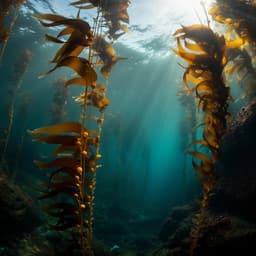
Earth Sciences
Drivers and impacts of the most extreme marine heatwave events
A. S. Gupta, M. Thomsen, et al.
This enlightening study investigates the severe impacts of marine heatwaves on ocean ecosystems and fisheries. Conducted by a team of experts, it reveals the intense characteristics, seasonal triggers, and ecological effects of these extreme events, highlighting the importance of past occurrences to better predict future oceanic changes.
~3 min • Beginner • English
Introduction
Marine heatwaves (MHWs)—prolonged periods of anomalously warm sea surface temperatures—pose major threats to marine ecosystems, fisheries, and ecosystem services. Their frequency and duration have increased markedly over the past century due largely to upper-ocean warming, with projections indicating order-of-magnitude increases in MHW days by century’s end even under strong mitigation. The study aims to identify and characterize the most extreme MHWs of the satellite era (1982–2017) using a standardized framework to uncover common generation mechanisms, links to large-scale climate modes (notably ENSO), seasonal dependencies, and typical ecological responses. By compiling a global database of extreme events and analyzing their physical drivers and associated surface chlorophyll-a responses, the work seeks to inform prediction and impact assessment of future MHWs.
Literature Review
Recent research has focused on defining MHWs and categorizing severity, local and remote drivers (ocean advection, atmospheric synoptic systems, and coupled air–sea processes), historical changes and future trends, and predictability. ENSO dynamics and forecasting have advanced substantially, with known links to detrimental ecosystem outcomes (e.g., mass coral bleaching, fisheries disruptions) and teleconnections that can trigger extra-tropical MHWs. Prior case studies include events such as the 2011 Ningaloo Niño, the 2014–2016 northeast Pacific Blob, and the 2009/10 central South Pacific MHW, but many extreme events remain undescribed in terms of drivers and impacts. The paper builds on this literature by systematically identifying commonalities across the most extreme global events.
Methodology
Definition and detection: A marine heatwave occurs when local daily SST exceeds the seasonally varying 90th percentile (PC90) for at least 5 consecutive days; interruptions <2 days below PC90 are bridged into a single event. Climatological baseline: 1983–2012. Percentiles computed using an 11-day moving window; daily climatology and percentiles smoothed with a 31-day filter. Data: NOAA 1/4° daily OISST v2.0. Severity metric: S = (SST - climatology) / (PC90 - climatology), categorized as moderate (1<S≤2), strong (2<S≤3), severe (3<S≤4), extreme (S≥4). A continuous severity index was used to rank events. Intensity and cumulative intensity: Intensity is SST anomaly (SSTA) during MHW; cumulative intensity is temporal integral of SSTA over the event. Spatial extent: Contiguous MHW areas identified by connected grid cells meeting MHW conditions at a time step; areas summed. Trend handling: No secular SST trend was removed (to reflect impacts on organisms with fixed thresholds). Event selection (“most extreme extremes”): Grid cells where the most severe day coincided with the event of largest cumulative intensity were flagged. Manual delineation of semi-contiguous regions with co-timed most severe and largest cumulative intensity events produced 62 regions. For each, time series were constructed for: fraction of region under moderate/strong MHW, largest contiguous moderate/strong area intersecting region, integrated intensity of that contiguous area, and number of cells experiencing their most severe day. From these, core date ranges were assigned and summary metrics computed (Table 1). Forcing analysis: For each region, normalized anomalies (relative to the same 4-week period across years 1979–2019) of 10 m winds (speed and zonal), mean sea-level pressure, downward shortwave and longwave radiation, latent and sensible heat fluxes were averaged during build-up (6–3 weeks prior) and decay (3–6 weeks after peak). Reanalyses: ERA-Interim for most variables; ERA5 for downward shortwave. Biological response: For 52 of 62 regions (since chlorophyll begins in 1997), 8-day GlobColor chlorophyll-a anomalies were computed relative to climatology, normalized by the regional standard deviation, and averaged over the MHW core period and area. Significance was assessed via Monte Carlo resampling on non-MHW dates. Background nitrate from World Ocean Atlas 2013 v2. Code availability: MHW calculation code (https://github.com/ecjoliver/MHW_Drivers); event processing and plots (https://github.com/alexsengupta/ExtremeExtremes.git).
Key Findings
- Global occurrence and severity: From 1982–2017, every 4° grid cell experienced at least one strong (category ≥2) MHW; >70% of ocean area experienced severe (category ≥3) and ~10% experienced extreme (category ≥4) conditions. - Intensity distribution: Typical maximum MHW intensities were ~2.5–3.7 °C (IQR), with >5% of the ocean exceeding 5 °C maximum daily SSTA. Regions of high maximum intensity include western boundary current extensions (Kuroshio, Gulf Stream), the Agulhas Retroflection, Brazil–Malvinas confluence, and areas of strong poleward advection (Leeuwin, EAC). - Seasonality: Most intense events preferentially occur in local summer. Globally, 39% of ocean area had its most intense MHW in DJF vs 23% in JJA (25% expected if uniform). By hemisphere: Northern Hemisphere: 45% in summer vs 9% in winter; Southern Hemisphere: 62% in summer vs 7% in winter. This seasonality aligns with shallow mixed layers and weaker winds in summer; long-term trends and climatology smoothing play minor roles. - ENSO modulation: During El Niño, the ocean area experiencing its highest category MHW rose sharply; moderate/strong El Niño persisted ~19%/~6% of the time, yet ~34%/~19% of ocean experienced its most severe MHW during those periods. In 2015/16, monthly area with highest-ever category events exceeded 3 million km² (5× average). La Niña did not suppress extremes globally; some regions (e.g., west Australia) saw their most severe events during La Niña. ENSO preconditioning explains only a small fraction (few tenths °C) of the 2–4 °C anomalies; local synoptic forcing and feedbacks amplify events. - Duration and cumulative intensity: For 80% of ocean, longest MHWs lasted 40–160 days; ~4% exceeded 250 days. There was a multi-decadal increase in extreme durations; ~60% of ocean experienced its longest-duration MHW since 2010. Cumulative intensity increases nonlinearly with duration; longer events also had higher mean SSTA. - Largest contiguous events: During 2015/16, contiguous MHWs in the central/eastern Pacific exceeded 10% of the global ocean area for >200 days; a one-day maximum of ~20% coverage occurred in March 2016 due to merging events. The largest non–El Niño contiguous event (May 2016, Indian Ocean) was linked to lingering Indian Ocean Basin Warming. There is a long-term increase in maximum contiguous extent, even excluding El Niño periods. - “Most extreme extremes”: Many top events coincided with major El Niño episodes (1982/83, 1997/98, 2015/16) and notable extra-tropical events (e.g., 2009/10 central South Pacific, 2014–2016 Blob). - Forcing mechanisms: 82% of extreme events had suppressed wind speeds during build-up; ~60% had suppressed latent/sensible heat losses. Persistent high-pressure systems frequently preceded subtropical/midlatitude extremes, inducing reduced winds, increased insolation, and warm poleward Ekman transport; some coastal or tropical cases involved low-pressure anomalies suppressing upwelling (e.g., California Current) or altering boundary currents (Ningaloo Niño). During decay, 79%/67% of events had enhanced latent/sensible heat losses; latent flux anomalies were typically ~3× sensible and ~2× insolation anomalies. Downward longwave radiation tended to be elevated during build-up and decay (>90% and >82% of regions). - Biological response: 72% of extreme MHWs showed anomalously low chlorophyll-a at the peak (p<0.01). All tropical (20°N–20°S) extremes had suppressed chlorophyll. At higher latitudes, chlorophyll response often flipped positive. Regions with low-to-moderate climatological nitrate saw stronger chlorophyll suppression; high-nutrient regions more often saw elevated chlorophyll during MHWs.
Discussion
The study demonstrates that the most extreme MHWs share robust commonalities: a strong seasonal preference for summer when mixed layers are shallow and winds are weak, and substantial modulation by ENSO that enhances intensity, duration, and spatial extent both within and beyond the tropical Pacific. However, ENSO-related preconditioning accounts for only a fraction of the observed anomalies, underscoring the critical roles of persistent synoptic atmospheric anomalies—especially high-pressure systems in subtropical/midlatitude regions—that reduce wind-driven mixing and turbulent heat losses, enhance insolation, and drive warm poleward Ekman transport. The decay of many events is associated with strong turbulent cooling, particularly via latent heat fluxes. Ecologically, extreme MHWs are generally linked to reduced surface chlorophyll-a at low and mid-latitudes, consistent with enhanced stratification limiting nutrient supply, while some high-latitude events show increased chlorophyll, likely due to reduced light limitation and retention of phytoplankton in the euphotic zone. These findings address the need to identify mechanisms and typical biological responses of the most impactful MHWs, informing prediction and risk assessment for ecosystems and fisheries in a warming ocean.
Conclusion
By systematically identifying the most intense, longest, and most extensive MHWs during 1982–2017, the study shows that extreme events are widespread, seasonally biased toward local summer, and strongly modulated by ENSO. Suppressed winds and persistent high-pressure systems emerge as common proximate drivers, while latent heat fluxes are key in event decay. Most extreme events at low-to-mid latitudes coincide with depressed chlorophyll-a, whereas high-latitude responses are more often positive. The analysis provides a catalog of extreme events and their physical and ecological characteristics, enabling targeted process studies and improved prediction. Future work should: (i) quantify full surface–subsurface heat budgets and three-dimensional structure using reanalyses and expanded observations; (ii) evaluate sensitivity to SST products and extend beyond extreme events to assess generality; (iii) incorporate stratification and light limitation to refine productivity impacts; (iv) use multispectral ocean-color data and in situ plankton observations to assess community changes; and (v) develop predictive frameworks that leverage identified atmospheric and oceanic precursors.
Limitations
- Surface focus: Analysis characterizes surface SST and surface fluxes; subsurface structure, mixing, and advection were not resolved due to limited observations (e.g., short ARGO record) and reanalysis constraints. - Heat budget not closed: Full quantitative heat budgets were not computed; attribution among fluxes, advection, and mixing remains incomplete. - SST product issues: Potential post-2016 AVHRR degradation may affect OISST quality; robustness to alternative SST datasets not tested here. - Trend handling: Secular warming trend was not removed to reflect ecological impacts; this limits direct attribution to climate modes. - Spatial extent metric: Pointwise MHW definition allows daily merging/splitting, complicating interpretation of contiguous extent. - Chlorophyll coverage: Chlorophyll analysis limited to 1997 onward (52 of 62 regions) and uses satellite surface proxies without direct community composition data.
Related Publications
Explore these studies to deepen your understanding of the subject.







